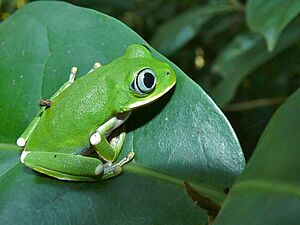Leptopelis kivuensis facts for kids
Quick facts for kids Leptopelis kivuensis |
|
|---|---|
 |
|
| Conservation status | |
| Scientific classification | |
| Synonyms | |
|
This frog, called Leptopelis kivuensis, is a type of frog that belongs to the Arthroleptidae family. You can find it in the high mountains of western Burundi, Rwanda, and Uganda. It also lives in the far eastern part of the Democratic Republic of the Congo. People sometimes call it the Kisenyi forest treefrog or the Kivu tree frog. It used to be thought of as the same as another frog, Leptopelis karissimbensis, but now we know they are different.
Contents
What Does the Kivu Tree Frog Look Like?
Adult male Kivu tree frogs are about 28–37 mm (1.1–1.5 in) long. This measurement is from their nose to their bottom. They have a small eardrum, which is called a tympanum. Their fingers and toes have only a little bit of webbing.
Colors and Patterns
The color of these frogs can change a lot. Adult males might be tan, reddish-brown, or light green. Some frogs that are tan or brown have light brown triangle shapes on their back. These shapes are found between their eyes and their lower back.
They might also have a dark brown line. This line goes from the front of their face, through their eye, over their eardrum, and down to their front leg. You might also see dark brown spots on their sides. Their upper legs can have dark brown stripes across them. Sometimes, there is a light-colored spot under their eye, but it might be hard to see.
Male Calls
Male frogs have a white throat sac. This is called a gular vocal sac. They use this sac to make a special sound. Their mating call is a single, quick "clack" sound. They repeat this sound very fast. Sometimes, they might even make a double "clack" sound.
Where Does the Kivu Tree Frog Live?
The Kivu tree frog lives in forests. It prefers high places, from 1,481–2,600 m (4,859–8,530 ft) above sea level. You can find it in wet areas in the mountains. It also lives where forests meet other types of land.
How Does the Kivu Tree Frog Reproduce?
These frogs lay their eggs in swamp forests. These areas get flooded during certain times of the year. The female frog buries her eggs in nests on the ground.
When heavy rains begin, the eggs hatch. The water from the floods then washes the tiny tadpoles into the water. This helps the tadpoles start their lives.
Is the Kivu Tree Frog Safe?
The Kivu tree frog is facing some challenges. Its home is slowly disappearing. This is happening because of farming, cutting down trees for wood, and people building new homes. This is called habitat loss.
However, many places where these frogs live are protected. They are found in several national parks. These parks help keep their homes safe. Some of these parks include:
- Kahuzi-Biega National Park in the Democratic Republic of Congo
- Virunga National Park in the Democratic Republic of Congo
- Rwenzori Mountains National Park in Uganda
- Kibale National Park in Uganda
- Bwindi National Park in Uganda
- Nyungwe National Park in Rwanda
These parks are very important for protecting the Kivu tree frog.


